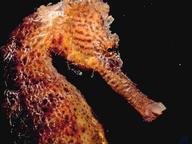
Seahorsin' Around Trivia Quiz
They can barely swim, they're sure not horses, they eat constantly, and they get pretty freaky during mating and pair-bonding. No, I'm not talking your cousin's family. I'm talking about the genus Hippocampus... seahorses to you. Enjoy the quiz!
A multiple-choice quiz
by JJHorner.
Estimated time: 3 mins.
- Home
- »
- Quizzes
- »
- Animal Trivia
- »
- Fish
- »
- Seahorses